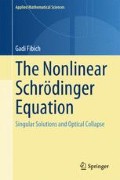Abstract
In this chapter we discuss the loss of phase of NLS solutions beyond the singularity.
Access this chapter
Tax calculation will be finalised at checkout
Purchases are for personal use only
Notes
- 1.
Loss of information at singularities occurs also in e.g., shock waves and black holes.
- 2.
A small perturbation leads to a small relative change in the accumulated phase. Since, however, the amount of accumulated phase is “almost infinity”, a small relative change can correspond to an \(O\)(1) absolute change. Indeed, assume that a perturbation of size \(\epsilon \) arrests collapse at \(z_\mathrm{arrest}=z_\mathrm{arrest}(\epsilon )\). The on-axis accumulated phase at \(z_\mathrm{arrest}\) is \(\zeta (z_\mathrm{arrest}) = \int _0^{z_\mathrm{arrest}} L^{-2}\). Since \(\lim _{\epsilon \rightarrow 0} \zeta (z_\mathrm{arrest}) = \int _0^{Z_\mathrm{c}} L^{-2} = \infty \), small changes in \(\epsilon \) can lead to \(O\)(1) changes in \(\zeta (z_\mathrm{arrest})\).
- 3.
We already saw the high sensitivity of the post-collapse phase in Fig. 38.1b.
- 4.
- 5.
This dynamics is shown in Fig. 38.1a for the un-tilted case \(({c} = 0)\).
- 6.
- 7.
As we already saw in Sect. 27.5.
- 8.
Recall that out of phase beams repel each other (Sect. 3.2.2).
Author information
Authors and Affiliations
Corresponding author
Rights and permissions
Copyright information
© 2015 Springer International Publishing Switzerland
About this chapter
Cite this chapter
Fibich, G. (2015). Loss of Phase and Chaotic Interactions. In: The Nonlinear Schrödinger Equation. Applied Mathematical Sciences, vol 192. Springer, Cham. https://doi.org/10.1007/978-3-319-12748-4_39
Download citation
DOI: https://doi.org/10.1007/978-3-319-12748-4_39
Published:
Publisher Name: Springer, Cham
Print ISBN: 978-3-319-12747-7
Online ISBN: 978-3-319-12748-4
eBook Packages: Mathematics and StatisticsMathematics and Statistics (R0)

